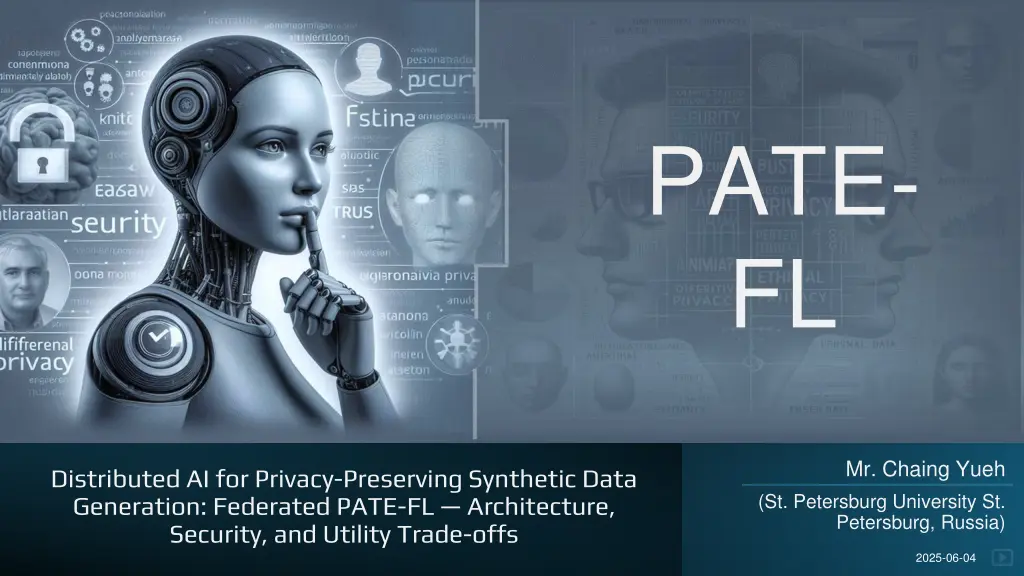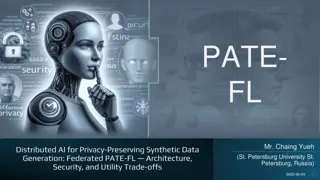
Secure AI Data Generation with PATE-FL Architecture
Explore the Federated PATE-FL Architecture for Privacy-Preserving Synthetic Data Generation, addressing critical obstacles in modern AI systems. Learn about Federated Learning, PATE, and RAFT technologies, ensuring secure, scalable, and responsible AI development in distributed environments while adhering to privacy regulations and addressing data accessibility challenges.
Download Presentation

Please find below an Image/Link to download the presentation.
The content on the website is provided AS IS for your information and personal use only. It may not be sold, licensed, or shared on other websites without obtaining consent from the author. If you encounter any issues during the download, it is possible that the publisher has removed the file from their server.
You are allowed to download the files provided on this website for personal or commercial use, subject to the condition that they are used lawfully. All files are the property of their respective owners.
The content on the website is provided AS IS for your information and personal use only. It may not be sold, licensed, or shared on other websites without obtaining consent from the author.
E N D
Presentation Transcript
PATE- FL Mr. Chaing Yueh Distributed AI for Privacy-Preserving Synthetic Data Generation: Federated PATE-FL Architecture, Security, and Utility Trade-offs (St. Petersburg University St. Petersburg, Russia) 2025-06-04
Problem Statement Modern AI systems face critical obstacles in data accessibility, privacy, fairness, and legality barriers that hinder 2025-06-04 reliable, scalable, and responsible development. High Cost of Data Collection and Labeling: Training AI requires large, diverse, and often rare examples cleaning and labeling consume most of the effort. Tightening Privacy Regulations: Laws like GDPR prohibit using personal data without consent. Italy fined OpenAI 15 million for violations. Most frameworks focus on distributed computation: Frameworks such as FATE, PyTorch, TensorFlow, and Flower mainly emphasize distributed computation and model training, providing only basic noise addition. They lack comprehensive mechanisms for privacy budget management and adjustment. 2 Rewind with solid fill Rewind with solid fill
INTRODUCTION This talk presents the technological foundation for secure, privacy-preserving synthetic data generation in distributed environments. To frame the discussion, we begin with short definitions of the three core building blocks: 2025-06-04 Federated Learning, PATE, and RAFT. Federated Learning (FL): A distributed machine learning paradigm where multiple participants (clients) collaboratively train a shared model without exchanging their raw data. FL is important because it enables scalable AI development across organizations, while keeping sensitive data local and reducing privacy risks. PATE (Private Aggregation of Teacher Ensembles): A privacy-preserving method based on aggregating predictions from an ensemble of independently trained teacher models, with added differential privacy noise. Unlike traditional gradient-based DP, PATE can provide stronger privacy guarantees by decoupling learning from direct data access and focusing on private label aggregation making it especially effective for distributed settings with sensitive data. RAFT Consensus: A lightweight distributed consensus protocol that ensures all participating nodes agree on a sequence of actions (such as model updates or aggregations). RAFT is designed for fault-tolerant, consistent coordination in distributed systems. Compared to more complex Byzantine Fault Tolerance (BFT) protocols, RAFT is simpler and more efficient for environments where trust assumptions are moderate, and consensus is needed for reliability rather than adversarial resilience. These three technologies Federated Learning, PATE, and RAFT form the foundation of the architecture discussed in this presentation. 3 Rewind with solid fill Rewind with solid fill
BACKGROUND & MOTIVATION Generative AI is rapidly evolving and has the potential to transform industries through efficiency and personalization. However, its widespread adoption is slowed by challenges such as poor data quality, centralized control, and growing cybersecurity threats. REALM addresses these issues by providing decentralized, privacy-focused AI solutions, ensuring businesses can innovate securely without compromising on data integrity. 2025-06-04 Distributed Intelligence at Scale Security & Privacy Demands Data stays local Collaboration without centralization. Escalating cyber threats Stringent privacy regulations As organizations generate ever more data, distributed learning allows them to benefit from collective intelligence without sacrificing local control. With the increasing sophistication of cyberattacks and tightening of privacy laws worldwide, secure and compliant data handling is more critical than ever. Federated, privacy-preserving approaches reduce the attack surface and provide strong, measurable privacy guarantees by design. FL enables cross-silo collaboration, where data remains on-site, unlocking value from diverse sources while meeting regulatory and data sovereignty requirements. Trust & Heterogeneity AI Expansion & Data Scarcity AI s hunger for diverse, high-quality data Synthetic data bridges data gaps. Building trust across untrusted parties Adapting to heterogeneous systems. Collaboration in AI must bridge gaps between diverse, often untrusted stakeholders and technology stacks. Distributed consensus and privacy-preserving aggregation (via PATE and RAFT) make it possible to build robust AI ecosystems that work reliably across organizational, geographic, and technical boundaries. Modern AI requires massive, varied datasets that are often siloed, private, or simply insufficient. PATE-FL Synthetic data generation within federated pipelines helps overcome these limitations, providing the volume and diversity needed to train robust AI models without exposing real data. 4 Rewind with solid fill Rewind with solid fill
FEDERATED LEARNING (FL) Federated Learning (FL) is a collaborative machine learning approach that trains models across multiple decentralized devices or servers holding local data samples, without exchanging them. This approach enhances data privacy, reduces latency, and leverages distributed data. 2025-06-04 Horizontal Federated Learning: Combines data from the same feature space but different samples, typically used when data from different sources share the same structure. Federated Transfer Learning: Applies transfer learning techniques in federated settings, useful when data from different organizations have different features and samples. Vertical Federated Learning: Combines data from different feature spaces but shares the same sample IDs, useful when organizations have different attributes of the same user. SERVICE: DRIVERS: Federated Data Analytics: Performing data analytics on distributed data sources without compromising privacy. Personalized Model Training: Developing personalized models for individual users or devices without sharing their data. Cross-Organization Collaborations: Enabling multiple organizations to collaboratively train models while maintaining data confidentiality. Edge AI Services: Deploying AI models on edge devices like smartphones and IoT devices for real-time, on-device inference. Data Privacy: Enhances privacy by keeping data on local devices and only sharing model updates. Reduced Latency: Improves training efficiency by leveraging local computation. Utilization of Diverse Data: Enables the use of data from various sources that cannot be centrally aggregated due to privacy concerns or data regulations. PATE-FL 5 Rewind with solid fill Rewind with solid fill
RAFT CONSENSUS 2025-06-04 Distributed systems require reliable mechanisms for consistent decision-making, especially in environments with potential failures. The RAFT consensus protocol ensures that multiple servers (or aggregators) agree on updates, guaranteeing robustness and tamper-resistance. TABULAR DATA WITH DP RAFT elects a leader to coordinate updates and maintain a shared log Followers replicate the leader s log; updates are committed only with a quorum Handles node failures, partitions, and ensures consistent state Essential for reliable, auditable aggregation in federated settings 2. Replicate Data 1. Submit 3. Acknowledge Receipt Leader Followers 4. Confirm Commit Log Synchronization PATE-FL Rewind with solid fill Rewind with solid fill
RISK MODEL 2025-06-04 Risk in the context of synthetic data generation pertains to the potential for data to expose sensitive information, lead to incorrect conclusions, or otherwise harm individuals or organizations Security metrics are calculated using a risk model. A risk model is a framework or method for measuring, evaluating, and managing the privacy risk associated with synthetic data. A risk model typically consists of the following components: A threat model that identifies an attacker's capabilities, goals, and strategies to execute attacks on the privacy of synthetic data. INFORMATIO N LEAKAGE A privacy criterion that determines the desired level of protection or acceptable level of risk for synthetic data. SPECIFIC RISK DIVERGENT MODEL A risk metric that quantifies the privacy risk of synthetic data by comparing synthetic data to raw data, or by assessing the likelihood or impact of attacks on the privacy of synthetic data. MODELS DIFFERENTI AL PRIVACY Risk score, which applies a risk metric to synthetic data and source data and calculates a risk score or risk level for synthetic data. Risk mitigation, in which some technique or mechanism is applied to reduce the privacy risk of synthetic data, such as adding noise, distorting features, or synthesizing new data. SYNTHETIC DATA FRAMEWORK . PNG HOMOMORPHI C ENCRYPTION 7 Rewind with solid fill Rewind with solid fill
GENERATION APPROACH 2025-06-04 Step into the realm of Generative Adversarial Networks (GANs) and Private Aggregation of Teacher Ensembles (PATE-GAN), where innovation meets privacy in the generation of synthetic data. TABULAR DATA WITH DP GAN Core Mechanism: GANs consist of two neural networks, the generator and the discriminator, engaged in a continuous game. The generator creates synthetic data, while the discriminator evaluates its authenticity, leading to a dynamic training process where the generator strives to produce increasingly realistic data. PATE-GAN : Privacy-Centric Approach: PATE-GAN extends the principles of GANs by integrating the PATE framework. It focuses on generating synthetic data that preserves privacy, making it particularly suitable for sensitive datasets where data utility and individual privacy must be carefully balanced. Mechanism: PATE-GAN leverages an ensemble of teacher models, each trained on disjoint subsets of the private data. It then aggregates their knowledge to guide the training of a student model (the generator) in a differentially private manner, ensuring that the synthetic data generated does not compromise individual privacy. Benefits and Challenges: PATE-GAN provides strong privacy guarantees, making it an ideal choice for scenarios requiring compliance with stringent data protection standards. Quality of Synthetic Data: While PATE-GAN aims to generate high-quality synthetic data, the balance between data utility and privacy is delicate and requires careful tuning of model parameters. Computational Complexity: The intricate architecture of PATE-GAN, involving multiple teacher models and a student model, can lead to increased computational complexity and resource requirements. PATE-FL 8 Rewind with solid fill Rewind with solid fill
SYNTHETIC DATA PRIVACY 2025-06-04 Synthetic data, based on real data, may reveal private information due to its fingerprint . This requires careful methods to create and use synthetic data. An ideal but unattainable spot with maximum scrutiny Quality Metrics for Synthetic Data: The utility of synthetic data is largely gauged by its quality specifically, how accurately it mirrors the real data's inherent characteristics, including correlations and dependencies. Assessing this quality necessitates the use of sophisticated metrics designed to quantify the fidelity and utility of the synthetic dataset. and safety security Trade-off Between Quality and Privacy: Similar to the challenges faced with real datasets, synthetic data is subject to a pivotal trade-off between quality and privacy. High-fidelity synthetic data might inadvertently lead to the risk of re-identification, wherein the synthetic dataset reveals identifiable links to real-world data, potentially exposing sensitive attributes. The Balance Point Between Utility and Security Risk Assessment and Mitigation: To navigate the delicate balance between data utility and privacy, it's crucial to quantify the level of risk. Employing specialized risk models enables stakeholders to assess potential privacy threats tailored to the data's nature and the contexts of its application. This risk-informed approach paves the way for crafting a harmonized balance between data quality and privacy safeguards. utility Merely generating synthetic data involving personal information is not an end in itself. It's imperative to constantly seek an equilibrium between data quality and security. In traditional data scenarios, techniques like k-anonymity are commonly employed to preserve privacy. For synthetic data engineered through AI methodologies, the principle of differential privacy stands out as a robust mechanism, offering a structured approach to managing privacy risks while retaining the utility of the synthetic datasets. This approach ensures that the synthetic data serves its intended purpose without compromising individual privacy. PATE-FL Rewind with solid fill Rewind with solid fill
Our Contributions Privacy-preserving federated learning requires more than secure aggregation it demands modular, auditable, and 2025-06-04 failure-resilient design. Encrypted Voting over Labels: We design a decentralized PATE-FL framework that replaces gradient aggregation with encrypted label-level voting, reducing leakage risk and enabling secure decision aggregation. Composable Privacy Mechanisms: By integrating homomorphic encryption with differential privacy, we enable flexible, verifiable combinations of query protection and model aggregation strategies. RAFT-Based Coordination Layer: We introduce a consensus protocol to manage synchronization, privacy budget tracking, and node failures, ensuring consistent and tamper- resilient federation. Synthetic Data Risk Evaluation: A dedicated testing platform simulates membership, attribute, and linkage attacks, offering quantitative insight into synthetic data privacy under adversarial inference. PATE-FL Rewind with solid fill Rewind with solid fill
SUMMARY AND OUTLOOK 2025-06-04 Modern federated and privacy-preserving learning systems offer new possibilities for safe synthetic data generation and collaborative AI. PATE-FL with consensus mechanisms like RAFT forms a practical, research-ready foundation for future deployments and real-world impact. TABULAR DATA WITH DP PATE-FL with RAFT delivers strong privacy and resilience for synthetic data The architecture is ready for further research, scaling, and real-world trials Next steps: live demo, expanded experiments, and open Q&A PATE-FL 11 Rewind with solid fill Rewind with solid fill
THANK YOU SYNTHETIC DATA FRAMEWORK 12
SYNTHETIC DATA ATTACKS Attack Type Model Inversion Attack Description Consequence Adversaries use the model's output to infer sensitive input data. Exposure of sensitive information, compromising individual privacy. Membership Inference Attack Attackers determine if specific data was part of the model's training set. Potential identification of individual data contributions, leading to privacy breaches. Malicious data is introduced into the training set, affecting learning. Compromised model integrity, leading to skewed or harmful outputs. Data Poisoning Adversarial Manipulation Deceptive data input exploits model vulnerabilities, causing wrong outputs. Eroded trust in model accuracy and potential manipulation for nefarious purposes. Model Stealing/Extraction Reverse-engineering a model to replicate its functionality and data. Unauthorized access and potential misuse of proprietary algorithms and data insights. Re-identification Attack Cross-referencing anonymized data with external sources to identify individuals. Violation of anonymity guarantees, leading to privacy invasions and potential legal ramifications. Attribute Inference Attack Using model outputs to infer sensitive attributes of individuals in the dataset. Exposure of sensitive attributes, leading to privacy breaches and potential misuse of data.
FEDERATED LEARNING Arrow: Counter-clockwise curve with solid fill MODEL LIFECYCLE Initiated Updated Model B Updated Model C Initialization Client Registry Aggregation Evaluated Client Selector Exchange Client Cluster Deployment Selector Local Model A Trained Model A Trained Model A Multi-task Model Trainer Inventive Registry Trai n Dataset A Heterogeneous data handler Model Co- versionning Registry Participant A Trained Initialization Initialization Updated Model A Updated Model A Message Compressor Deployed Aggregation Aggregation Model Asynchronous Aggregator Replacement Trigger Local Model B Local Model C Trained Model C Trained Model B Train Train Decentralized Aggregator Monitored Dataset B Dataset C Secure Aggregator Participant B Participant C Abandoned 6/4/2025 COLLABORATION HELTHCARE AI 14 Aggregated
INFORMATION LEAKAGE MODEL The model evaluates the risk of leakage of confidential information from synthetic data, as well as the probability of identifying or recovering original data from the synthetic dataset. Leakage refers to the ability to extract sensitive information about real data or individuals from synthetic data possible. The risk of information leakage can be assessed by considering three key aspects(Giomi Matteo, 2022): Arrow: Counter-clockwise curve with solid fill Singling Out: An estimate of the probability that it can be determined whether a unique record exists in the source dataset with a specific combination of attributes. Linkability risk refers to the ability to link records belonging to the same person or group of individuals in the source and synthetic set. Inference: The ability to guess unknown attributes of the original data record from synthetic data. Original Set Selection: A unique record with specified attributes Synthetic dataset Linking Record s Conclusion: Guessing Unknown Attributes
The normalized Kullback-Leibler distance is calculated as the ratio of the KL distance to the maximum possible KL value: DIVERGENT MODELS Divergent models are based on the idea of estimating the differences between two distributions of data the original dataset and the generated synthetic set. These models help to quantify how closely synthetic data reproduce the statistical characteristics of the original data, as well as to identify potential information leaks. Divergent Model Limitation Arrow: Counter-clockwise curve with solid fill Outlier Sensitivity: Divergent models may be overly sensitive to outliers, leading to skewed representations or analyses. These models might overemphasize or underrepresent the impact of data points that significantly deviate from the majority of the dataset. Normalized Euclidean distance between sets: Dependency Complexity: Divergent models often focus on capturing linear relationships between variables, potentially overlooking the more complex, nonlinear interactions. This limitation can result in a partial or superficial understanding of the underlying data dynamics. Interpretation Challenges: The results produced by divergent models can be intricate and subtle. Interpreting these results correctly requires a nuanced understanding of the model's behavior and the specific context of the data, making it a challenging task that demands expertise and careful consideration. Apply divergence metrics, such as the Kullback-Leibler divergence (KL divergence) or the Jensen-Shannon divergence (JS divergence), to quantify the differences between distributions. Original Set Comparison of distributions The Jaccard Index also measures the proximity between two sets based on the ratio of their intersection to the union: Synthetic Dataset
RISK MODEL FOR SEMI-STRUCTURED DATA 1. Vectorize text with FastText, Word2Vec, or GloVe: These models create vector representations of words by learning on large corpora of texts and capturing the semantic relationships between words. Word2Vec uses contextual words to predict the current word (CBOW) or the current word to predict its context (Skip-gram), while GloVe builds a word co- occurrence matrix and factorizes it. Word2Vec uses contextual words to predict the current word (CBOW) or the current word to predict its context (Skip-gram), while GloVe builds a matrix of word occurrence and factorizes it. Arrow: Counter-clockwise curve with solid fill Reliable cleaner / cleaning services / airbnb cleaner 150 $ per service GTA Richmond Hill Barrie Orillia. Details We specialize in: Deep Cleaning Post Construction Renovation Airbnb cleaning and Hosting Residential Cleaning Contact Karla Garcia Location : 647--490 5XXX import fasttext import fasttext.util ft = fasttext.load_model( cc.en.300.bin') word = computer word_vector = ft.get_word_vector(word) print(f"Vector representation of a word'{word}':\n{word_vector}") FASTTE XT Shine cleaning services we have Pleasure to service in Aurora ,Richmond Hill,Newmarket,Bradford,Innisfil and barrie more the 10 Years expirence with are family businness with love to taken care the most precious thing people have your cozy and beautiful homes With services businnes,comercial,industrial,move out move in ,school,daycare,dentist,arquitect etc Please fill free to call as for free estimated anything with are Placer to services everyone. 2. Retrieving the Ad Vector: Averaging or summing word vectors: Convert an ad to a vector by averaging or adding the vector representations of all the words in the ad. 3. Integration of additional attributes: Explicit attributes (price, area, etc.) are converted into numerical vectors using techniques such as one-hot encoding, scaling, or embedding. Vectors are concatenated 4. Comparing Vectors Using Cosine Similarity: calculate the cosine similarity can be conveniently calculated using the scikit-learn library Synthetic data Real- world data Cosine similarity immediately provides a score for a risk for which a threshold can be set. For example, if you want to consider vectors similar when the cosine similarity is greater than or equal to 0.7 (which corresponds to an angle of about 45 degrees or less), you can set such a threshold. This means that the closer the cosine similarity value is to 1, the smaller the angle between the vectors and the greater their similarity.
Arrow: Counter-clockwise curve with solid fill DIFFERENTIAL PRIVACY The differential privacy model is an approach to protecting the privacy of individual data in a data set by allowing data analysis to be conducted without revealing specific information about individual individuals. A brief description of the main aspects of the differential privacy model: Arrow: Counter-clockwise curve with solid fill Data sensitivity analysis is performed to determine how much a change or deletion of a single record in the source data affects the output of the generator Regeneration Data Sensitivity Analysis The sensitivity of the data can be computed using various metrics, such as the Euclidean distance, or the Kuhlback-Leibler divergence ORIGINAL DATASET The model is also saved for future reference Data Sensitivity Differential privacy is a formal definition of privacy that ensures that the addition or removal of a single item from a data set will not have a significant impact on the results of the data analysis. Confidentiality: Differential privacy techniques provide a mechanism whereby conclusions drawn from data do not reveal sensitive information about individuals, making the results of the analysis virtually indistinguishable, regardless of the presence or absence of a specific record in the data. Noise mechanisms. Noise-adding mechanisms are often used to achieve differential privacy. These can be a variety of methods, including adding Laplace or Gaussian noise to the results of data queries. Privacy budget. The differential privacy model uses the concept of a "privacy budget," commonly referred to as a (epsilon). A low value corresponds to a higher level of privacy, but it can reduce the accuracy of the analysis results. Model Generating Noise from the Laplace Distribution Synthetic data Dataset available to the Attacker The generator tries to produce realistic synthetic data from the noise PUBLIC DATASET Here, is a differential privacy parameter. The formula assumes that the synthetic data is generated by a differentially closed algorithm that ensures that the output does not change materially if any particular record in the source data is changed or deleted. The formula also assumes that the attacker has unlimited basic knowledge and supporting information, and that the attacker can perform any type of attack on the privacy of synthetic data. When it comes to generating synthetic data using AI, differential privacy is one of the most effective approaches to ensuring data privacy.
HOMOMORPHIC ENCRYPTION The Homomorphic encryption allows computations to be performed directly on encrypted data, such that the results remain encrypted and can later be decrypted to yield the same outcome as if operations had been performed on the plaintext. Arrow: Counter-clockwise curve with solid fill Confidentiality: With homomorphic encryption, sensitive data remains encrypted throughout the entire processing pipeline. This ensures that intermediate parties, including aggregators or coordinators, cannot access the raw inputs or partial results. Additive operations: Paillier encryption supports addition operations under encryption. It allows values (e.g., votes, numerical results) to be aggregated securely without decryption. For example, encrypted votes from multiple sources can be summed, and only the final total is decrypted. Key separation & decryption: The private key required for decryption is kept strictly on the designated secure server. Even if data is intercepted or mishandled during transmission, no meaningful information is leaked unless the decryption key is compromised. Partial vs. Fully Homomorphic Encryption: Compared to fully homomorphic encryption, partial homomorphic encryption is not only more efficient and practical for federated learning, but also usually offers better integrity and security in practice, although it supports only specific operations such as addition. Additive homomorphism: Encrypted values can be summed directly without decryption
Arrow: Counter-clockwise curve with solid fill GENERATION LIFE CYCLE Generation and enrichment Preparation (Pre-processing) Real-world data (Legacy) Synthetic data Synthetic Data Generation Downstream Processing (Post-Processing) Parameter Tuning Cost Estimation (Efficiency) Model Round Report Assessment of accuracies (fidelity) Final Report Valuation utility Synthetics Privacy Assessment Evaluations & Validation
GANs ARCHITECTURE Arrow: Counter-clockwise curve with solid fill Input: Data (either actually from the dataset or generated by the generator). Convolutional layers: Reduces the spatial dimensions of the input set while increasing the depth (number of bands). Batch Normalization: Like the generator, it stabilizes learning. Leaky ReLU Activation Function: Helps solve the problem of gradient fading Sigmoid Activation Function: Used in the last layer to classify the input image as real or fake. Feedback Loop Random Noise Vector SYNTHETIC DATA DISCRIMINATOR NOISE GENERATOR Transaction Date and Time: The generated dates that correspond to the actual time interval. Identifiers: Generated identifiers that correspond to valid identifiers. User Profile: Social Media Profile Credit Score: Credit Data Balancing: Account Balances and Other Summary Characteristics Additional Features: Similar to real data, but values can be generated. Latent Space The hidden space from which the random vector is extracted CSV METRICS (classification loss ) Datasets RISK METRICS CT-GAN Working GAN Loss Functions Binary Cross-Entropy Loss: Commonly used to distinguish between real and generated images. Generator Loss: Measures how well the generator was able to cheat the discriminator. DENSE Data Pre-processing DATA AGGREGATION FFT Fast Fourier Transform Input: Random noise vector (hidden by vector or z-vector). Deconvolutional Layers (Transposed Convolution): Increases input noise sampling. Processing is done using LTSM for time series with a large number of channels. Batch Normalization: Stabilizes training by normalizing the inputs of each layer. ReLU Activation Feature: Used in all layers except the last one. Tanh Activation Function: Used in the last layer to create the output set. Scales the output from -1 to 1. REAL DATA WAVELE T Signal decomposition BATCH Date and time of the transaction: When the purchase or sale was made. Business Data: Data resulting from internal processing, correlated with the selected business model. 3rd Party Data: External Data Updated weights Production Flow Learning Environment Flow
PATE-GAN ARCHITECTURE PATE-GAN (Private Aggregation of Teacher Ensembles - Generative Adversarial Network) is a method that combines the principles of differential privacy and generative adversarial networks (GANs). The main goal of PATE-GAN is to generate synthetic data that is statistically similar to real data, while ensuring the protection of sensitive information contained in this data. Arrow: Counter-clockwise curve with solid fill each of the Teachers understands only a part of the source data in order to ensure privacy. Teacher Kits The Generator uses feedback from the Student (who is trained on Teachers' voices with added noise) to improve the quality of the generated data Back Propagation Adding noise (Opacus library) to teachers' responses is necessary to ensure differential privacy. Types of noise: Noise can be generated in a variety of ways, including Gaussian noise, Laplace noise {Random People} Teacher 1 Add noise on Aggregation Classifier (acts as a discriminator) Generated samples Votes of Teachers Student Loss Noisy Labels Teacher votes Aggregation Teacher 2 {Noise} Student Back Propagation Generator Architecture: A CT-GAN/WGAN neural network that takes the input noise signal and converts it into synthetic data. Loss function: The generator is optimized to minimize the difference between generated and real data. - adversarial loss, which takes into account how well the generator cheats the discriminator. Once the Generator is optimized, it is used to generate the final synthetic {SyntheticPeople} dataset, which is statistically similar to {RandomPeople}, but with data privacy. 1 (for real data) or 0 (for synthetic data). Votes are aggregated for each sample of data, usually by counting upvotes and downvotes (e.g., majority votes). Architecture: The student is a single model trained on noisy responses from teachers. Loss function: loss functions for classification, such as cross-entropy Architecture: CT-GAN/SDV. Teachers in PATE-GAN are a set of individual models trained on different subsets of real-world data. Every teacher can be a simple model, such as logistic regression Loss Function: Adversarial Loss: Binary Cross-Entropy (BCE) Loss Conditional Loss: Implemented through mechanisms that penalize the model for generating data that does not meet the specified conditions. Teacher k {Synthetic People} Splitting the Teacher Set {RP1},{RP2} Teacher Training for 0/1 Voting Teacher Aggregation Teacher Classification (0/1) Adding Noise Student Training Formation of the final set Preparing {Random People} Learning Cycle Preparing Noise (Random Vector) The generator generates synthetic data
Arrow: Counter-clockwise curve with solid fill DIFFERENTIAL PRIVACY AI ARCHITECTURES High (differential privacy through noise aggregation) Complex (complexity of aggregation and noise) High (multiple teachers and noise aggregation) High PATE-GAN High (differential privacy in gradients) Medium to High (depends on adding noise) Medium (frameworks available, but customization required) Medium (depends on model size and data) DP-SGD Medium to high (depends on conditions and noise) Complex (conditional generation + privacy) High (conditional GAN architecture + differential privacy) High (Differential Privacy) DP-CGAN Medium (the difficulty of balancing noise recovery and privacy) Relatively simple (extensively researched, lots of resources) High (if noise is applied correctly) Autoencoder-based Models with Differential Privacy Medium (depends on noise and recovery capacity) Medium to high (depends on the complexity of the model) Low (no special privacy measures) Medium (depending on the complexity of the model) High (with proper training) Regular GAN BENEFITS OF USING PATE-GAN: Protect your privacy: PATE-GAN provides strict differential privacy guarantees, which is critical when working with sensitive data such as financial information in CHURN analysis. Data privacy is maintained at all stages, from teacher training to synthetic data generation. Synthetic Data Quality: PATE-GAN is capable of generating high-quality synthetic data that preserves the statistical properties of the original {Random People} data. This ensures the realism and usefulness of synthetic data for CHURN analysis. Balance between Privacy and Informativeness: The PATE mechanism strikes a balance between protecting privacy and keeping data intelligent. This allows researchers and analysts to conduct in-depth and accurate analysis of customer churn. Flexibility & Scalability: PATE-GAN offers flexibility in the choice of teacher and student architecture, which allows you to optimize the system for the specific needs and volume of CHURN analysis data. Integrating Knowledge from Multiple Sources: With the help of multiple teachers, each trained on a subset of data, PATE-GAN is able to integrate and synthesize knowledge, providing a deeper understanding of customer churn patterns. Ensure Regulatory Compliance: In the face of stringent data protection requirements, PATE-GAN provides an effective data analysis solution without compromising privacy regulations.





